This article does not cite any sources .(December 2014) (Learn how and when to remove this template message) |
| SP42 | |||||||||||||||||||||||||||
|---|---|---|---|---|---|---|---|---|---|---|---|---|---|---|---|---|---|---|---|---|---|---|---|---|---|---|---|
 | |||||||||||||||||||||||||||
| |||||||||||||||||||||||||||
| |||||||||||||||||||||||||||
| |||||||||||||||||||||||||||
| |||||||||||||||||||||||||||
SP42 is the name for a Polish diesel locomotive used for passenger services.
This article does not cite any sources .(December 2014) (Learn how and when to remove this template message) |
| SP42 | |||||||||||||||||||||||||||
|---|---|---|---|---|---|---|---|---|---|---|---|---|---|---|---|---|---|---|---|---|---|---|---|---|---|---|---|
 | |||||||||||||||||||||||||||
| |||||||||||||||||||||||||||
| |||||||||||||||||||||||||||
| |||||||||||||||||||||||||||
| |||||||||||||||||||||||||||
SP42 is the name for a Polish diesel locomotive used for passenger services.
The SP42 is in fact the same locomotive as SM42, but modified for passenger transport. The modification was carried out by adding a heating system for passenger cars on the locomotive. Withdrawal of this class started in '90s, some of them was rebuilt into SU42 class (electrical heating instead of steam). SP42 class were totally withdrawn from PKP's service in year 2008. The last one (number 007 from depot Skarżysko Kamienna) made its special run with Bhp class double deckers from Skarżysko to Tomaszów Mazowiecki.
This loco used to be called the following names:
| Wikimedia Commons has media related to Fablok 101D . |
| This diesel locomotive-related article is a stub. You can help Wikipedia by expanding it. |
| This Polish rail-related article is a stub. You can help Wikipedia by expanding it. |

The British Rail Class 47 is a class of British railway diesel-electric locomotive that was developed in the 1960s by Brush Traction. A total of 512 Class 47s were built at Crewe Works and Brush's Falcon Works, Loughborough between 1962 and 1968, which made them the most numerous class of British mainline diesel locomotive.

Under the Whyte notation for the classification of steam locomotives by wheel arrangement, 4-6-0 represents the configuration of four leading wheels on two axles in a leading bogie and six powered and coupled driving wheels on three axles with the absence of trailing wheels. In the mid 19th century, this wheel arrangement became the second most popular configuration for new steam locomotives in the United States of America, where this type is commonly referred to as a Ten-wheeler. As a locomotive pulling trains of lightweight all wood passenger cars in the 1890-1920s, it was exceptionally stable at near 100 mph speeds on the New York Central's New York to Chicago Water Level Route and on the Reading Railroad's Camden to Atlantic City, NJ, line. As passenger equipment grew heavier with all steel construction, heavier locomotives replaced the Ten Wheeler.

In rail transport, head-end power (HEP), also known as electric train supply (ETS), is the electrical power distribution system on a passenger train. The power source, usually a locomotive at the front or 'head' of a train, provides the electricity used for heating, lighting, electrical and other 'hotel' needs. The maritime equivalent is hotel electric power. A successful attempt by the London, Brighton and South Coast Railway in October 1881 to light the passenger cars between London and Brighton heralded the beginning of using electricity to light trains in the world.

SU45 is a Polish diesel locomotive. It had been made for universal use: heavy transport or passenger transport alike.

The M62 is a Soviet-built diesel locomotive for heavy freight trains, exported to many Eastern Bloc countries as well as to Cuba, North Korea and Mongolia. Beside the single locomotive M62 also twin versions 2M62 and triple versions 3M62 have been built. A total number of 7164 single sections have been produced, which have been used to build 5231 locomotives.

SM42 is the PKP class for a Polish road switcher diesel locomotive for shunting and light freight traffic, built by Fablok in Chrzanów.

SU46 is the name for a diesel universal purpose locomotive working for Polish PKP. Cegielski has produced 52 machines in years 1974-1977 and 2 modified in 1985.
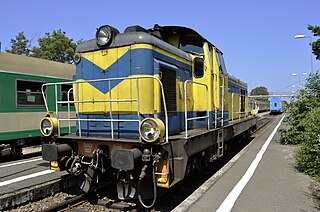
SU42 is the name for a Polish diesel locomotive used for universal purposes.

SP45 is the name for a Polish diesel locomotive. It was built for the purpose of passenger traffic. No operating examples of this loco remain. All have been phased out or rebuilt into SU45.
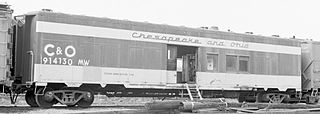
A steam generator is a type of boiler used to produce steam for climate control and potable water heating in railroad passenger cars. The output of a railroad steam generator is low pressure, saturated steam that is passed through a system of pipes and conduits throughout the length of the train.

The DRB Class 50 is a German class of 2-10-0 locomotive, built from 1939 as a standard locomotive (Einheitsdampflokomotive) for hauling goods trains. It had one leading axle and five coupled axles and was one of the most successful designs produced for the Deutsche Reichsbahn.
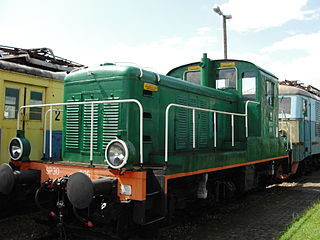
SP30 is a Polish series of diesel passenger locomotives used by PKP.
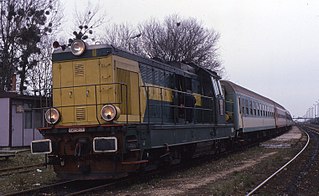
SP32 is a Romanian series of diesel passenger locomotives used by PKP.
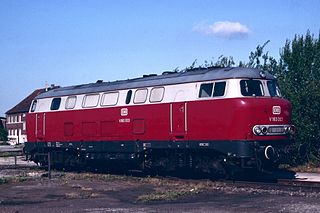
The Class V 160 is a class of diesel-hydraulic locomotives of the German railways. It is the first variant of the V160 family, built for the Deutsche Bundesbahn for medium/heavy trains.

The DB Class 215 is a 4 axle diesel locomotive of the V 160 type. They were built for the German Federal Railways for passenger and freight service on secondary and primary routes, and later passed to the Deutsche Bahn AG.

The South African Railways Class 3E of 1947 was an electric locomotive.

The South African Railways Class 7A 4-8-0 of 1896 was a steam locomotive from the pre-Union era in the Cape of Good Hope.

The South African Railways Dock Shunter 0-4-0ST of 1903 was a steam locomotive from the pre-Union era in the Cape of Good Hope.
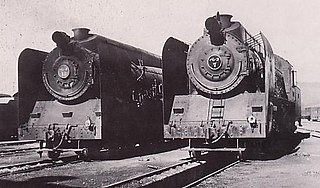
The Pashiko class (パシコ) locomotives were a group of steam tender locomotives of the Chosen Government Railway (Sentetsu) with 4-6-2 wheel arrangement. The "Pashi" name came from the American naming system for steam locomotives, under which locomotives with 4-6-2 wheel arrangement were called "Pacific".

T478.3 is a class of locomotives built for Czechoslovak State Railways to replace the most powerful steam locomotives in heavy passenger and freight service. Their design is based on the type T478.1; the main difference is the new, more powerful V12 diesel engine.